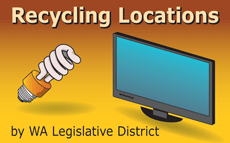Paint: NWPSC Programs
 Oregon Paint Stewardship Pilot Program (PaintCare Oregon)
Oregon Paint Stewardship Pilot Program (PaintCare Oregon)
The Oregon Department of Environmental Quality (DEQ) approved the Oregon Paint Stewardship Pilot Program Plan (PDF) setting in motion the first paint product stewardship "take-back" program in the nation that began on July 1, 2010. The program is operated by the PaintCare stewardship organization and is funded by an assessment on paint that is sold in Oregon. The program gives consumers the ability to return unused paint to participating retailers and other sites for proper recycling or disposal.
The PaintCare program was established under the Oregon Paint Product Stewardship law, Enrolled House Bill 3037 (PDF), which was passed by the 2009 Oregon Legislature. The law directs manufacturers of paints sold in Oregon to set up and run "a convenient, statewide system" for the collection of post-consumer latex and oil-based paint.
This pilot program is an oucome of the Paint Product Stewardship Inititative (PPSI) conducted by the Product Stewardship Institute. Goal 6 of the PPSI 2008 demonstration project work plan (Word document) was to "measure and evaluate the performance of the Demonstration Project, and ensure the results and learning that the evaluation generates are transferable and relevant to the rollout of a national post-consumer paint management system." To achieve this task, PPSI formed an Evaluation Committee with representatives from Oregon DEQ, the ACA, PSI, Oregon Metro Government, roll-out states, paint manufacturers, U.S. Environmental Protection Agency (EPA), and EPA’s contractor. Information about the evaluation questions, methodology, preliminary results, as well as the PaintCare 2011 first annual report, are available at the PPSI Evaluation Committee website.
 National Paint Product Stewardship Initiative (PPSI)
National Paint Product Stewardship Initiative (PPSI)
The NWPSC participated in the Paint Product Stewardship Initiative (PPSI) initiated in 2003 by the Product Stewardship Institute (PSI). The PPSI was a collaborative effort among state and local governments, manufacturers, retailers, paint recyclers, paint contractors, and environmental/consumer advocates to develop leftover paint management solutions that are both financially and environmentally sustainable.
In October 2007, the National Painting and Coatings Association (NPCA, now known as the American Coatings Assocation (ACA)) and PPSI finalized a second Memorandum of Understanding (MOU). View the list of agency signers (Word).
The MOU called for the establishment of an industry-funded Paint Stewardship Organization to collect and manage leftover paint using a pass-through cost to consumers. The agreement also committed stakeholders to conduct a Demonstration Project (pilot project) in Minnesota in July 2008, and then full programs in Washington, Vermont, and Oregon in January 2009, and other states after that time. This schedule was altered after Minnesota’s enabling legislation was vetoed by their governor. As a result, Oregon passed legislation in 2009 and began the paint stewardship pilot program in July 2010. A PPSI committee evaluated the Oregon Paint Product Stewardship Pilot program and created a website where the evaluation can be viewed.
 Paint Collection Cost Model
Paint Collection Cost Model
The Northwest Product Stewardship Council engaged Cascadia Consulting Group to design a methodology to measure direct and indirect costs associated with the collection of paint (oil-based and latex) and mercury lamps for recycling. The Excel-based financial model (Excel) can assist existing and potential Moderate Risk Waste (MRW) collection sites to estimate the cost to collect paint and mercury lamps at their facilities.
Two time-and-motion studies were conducted using this model and its accompanying guidance documents: the first in November 2010 in Snohomish County and the second in January 2011 in Kitsap County.
- MRW Collection Cost Model (Excel)
- Instructions (PDF)
- Diagram and Summary (PDF)
- Explanatory Memo (PDF)
- Sample Data Collection Sheet (PDF)
This presentation (PDF), from the September 2011 NAHMMA / PSI Conference in Portland, OR, explains the relevance of collection costs on product stewardship systems and provides an overview of the cost model and the time-motion studies used to develop the model.
